Finishing a door with leatherette is an inexpensive way to insulate a home and diversify its design. On sale you can find different colors of this material, which allows you to choose the right trim. Even a person without special skills can fit the front door.
Description of leatherette and its characteristics
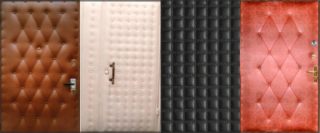
The material is a cotton-based leatherette, to which a nitrocellulose coating is applied. Sometimes they process not only the front, but also the seamy side. Dermantin is widely used in the textile industry for the upholstery of sofas, armchairs, and interior decoration of car interiors. It is also used for making bags, wallets, book bindings. It is easy to cut, does not tend to wrinkle or shrink.
When buying leatherette, you need to check that cracks do not appear on it when stretched. They also pay attention to wear resistance: it is not recommended to take samples with a value of less than 30 thousand cycles. The higher the number, the longer the leatherette will last. For the outer door, the factor of ultraviolet tolerance is also important.
The material is attractive for its resistance to rotting and contamination by parasites, it creates a barrier to moisture penetration into the underlying layers, which makes it possible to additionally protect the wooden door. It is unpretentious in care, calmly tolerates the effects of various detergents. The service life of the dermantine cladding is about 10 years.
The disadvantage of the material is that it is not resistant to physical damage: even a small gap requires replacing the coating. Also, leatherette is flammable. Moreover, many of its species tolerate frosts well (up to -35 degrees).
Surface preparation and necessary tools
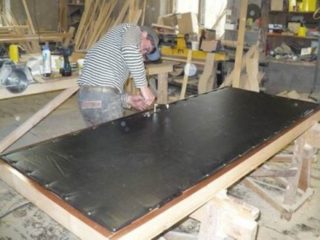
Before sheathe the door with leatherette with your own hands, you need to prepare it. If it was previously upholstered with any material, it is completely removed. It is imperative to dismantle the handles and hinges. The freed surface can be dusted off with a dry cloth. The details of the implementation of the upholstery process depend on the material of the door.
It is necessary to correctly calculate the material consumption. To the dimensions of the perimeter of the door add 15 cm to the right, left, top and bottom. These will be the dimensions of one cut of the material. For the upholstery, you need two such pieces. They should not have any breaks or damage.
The work will also require:
- scissors and knife;
- ruler;
- a hammer
- cuts of leatherette for rollers: two of them are cut along the width of the door, and the third has a length equal to its height and a width of 140-150 mm;
- foam rubber or isolon for lining and rollers;
- pliers;
- 5-6 dozen nails;
- furniture stapler.
If the door is made of metal, it can be finished without nails. In this case, glue is used (it needs about 100 g).
Fastening the lining
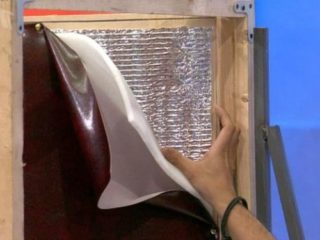
Before you upholster the door with leatherette, you need to organize a heat-insulating layer. Traditionally, foam rubber is used for this purpose. But if possible, it is better to give preference to the new generation material - isolon. It has the best noise and heat insulation properties.
If a wooden door is sheathed, work begins with the manufacture of rollers. On the structure, leatherette strips are reinforced with the front side down, using a stapler. They stretch the tubes of the insulating material and make turns, closing it.Stapling is carried out. On the underside of the roller to the floor surface, there should be a distance of at least 10-20 mm so that the material does not rub from constant contact with a rigid surface.
Mount the lining. The material is stapled from the center of the blade to reduce the risk of skewing. The distance from the edge of the canvas should be 1-2 cm. Batting can be mounted on top of the insulation so that the foam rubber or izolon is not damaged.
In the case of a metal structure, the work is done differently. The canvas is removed and placed on a flat surface. It is smeared with adhesive around the perimeter. It is also worth applying it to the central area. Then an insulating layer is fixed on top and gently pressed against the surface. The structure must be left for a while to allow the glue to dry.
Stages of door upholstery with leatherette
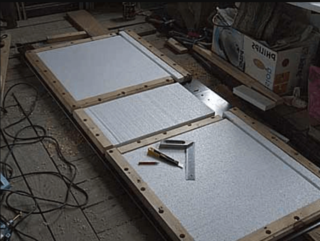
When working with a wooden door, the leatherette is tucked from above by 60-80 mm and fixed with nails. In this case, you need to look so that it does not fold into folds. Then the material is straightened with simultaneous pulling from the sides and nailed along the perimeter. The surface should be perfectly flat. The distance between the nails should be 5-10 cm. It is important to check that the fastening areas of the insulating rollers do not appear from under the folded part. An indent of 0.5-1 cm is made from the edge so that the fresh coating does not obstruct the movement of the door.
If it is necessary to upholster a metal sheet, staples and adhesive are used. The outer parts of the cover are folded up. They are reinforced from the inside with staples. Spread on the glue and then press down. In the process of work, you need to move gradually in one direction.
Final door decoration
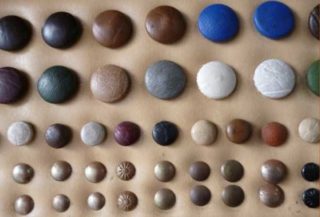
When the structure is ready, it is necessary to fix the fittings. In addition, to decorate the surface, you can make a pattern on the leatherette door.
To install the fittings, holes are made in the casing, the dimensions of which should be slightly smaller than those of the door leaf. This procedure will not be difficult, since the holes can be easily felt through the coating and insulation. Then they install the hinges, handles, lock structure, peephole. After that, the canvas can be installed in the opening.
One of the options for finishing the upholstery is to use furniture nails. The proposed decor is easier to perform on a wooden canvas, but it is also possible on a metal one if the insulation layer is of sufficient thickness and density. On the canvas, the places of installation of the nails are marked and then the hammering is carried out. After that, you can install a decorative cord under them. As a result, a pattern appears on the structure. You can use this method to create a classic diamond pattern or make a more complex ornament.
When working with a metal cloth, the decorative elements are reinforced with a strong thread on the reverse side even before sheathing, connecting leatherette with insulation.








